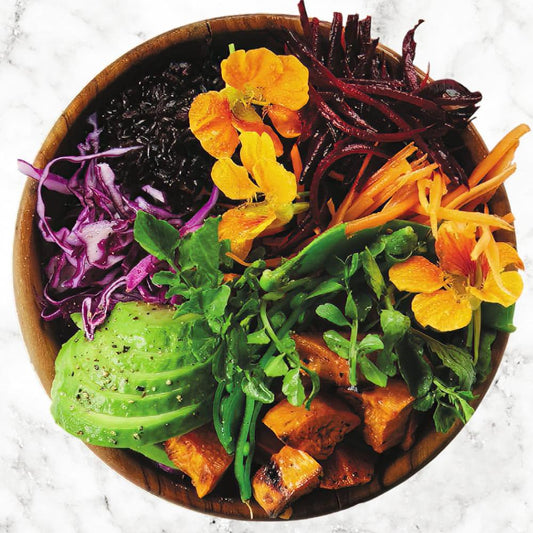Loaded with nutrients and health-promoting compounds such as vitamin C, vitamin A, potassium, nitric oxide, iron, and folate (just to name a few), beets are one of the healthiest foods you can eat.
The health benefits of beets can be felt throughout the entire body from the brain and heart to the digestive and immune systems. That’s why it’s recommended to eat this superfood about twice a week to live a healthier life.
The health benefits of beets are known all around the world, and that’s why the production of beets continues to rise year after year. Russia is the leading beet producer, with France coming in second and the US in third. However, it is believed that beets originally come from the Mediterranean area.
Evidence of beets has been found in the hanging gardens of Babylon from the 6th century BCE, the city of Pompeii from the early 1st century AD, and all across the expanse of ancient Greece and Rome.
The ancient Greeks believed that beets had aphrodisiac qualities, and in Greek myth, beets were a favorite food of Aphrodite, the goddess of love!

Originally used for medicinal purposes, the bulbous root which we eat today was surprisingly ignored. The plant’s leaves and stalks were eaten instead. It wasn’t until the 1500s that the fibrous beetroot became a common food.
Since then, it has become a staple in the cuisines of countries all around the world. And, with the increasing popularity of healthier, plant-based lifestyles, beets are more in demand now than they’ve ever been before.
The Top Health Benefits of Beets

Beets improve athletic performance
Beets are amazing sources of nitric oxide. Nitric oxide is a compound that widens blood vessels, increases blood flow, improves lung function, and strengthens muscles — all at the same time — making it the perfect food for athletes.
Drinking beet juice during a workout can stimulate your body and improve your stamina for a longer, more effective workout session.
Beets boost the immune system
Beets have the power to strengthen your immune system in multiple ways. Firstly, they increase the growth of beneficial bacteria in the gut. These good bacteria boost the immune system and help fight against the disease.
Besides that, beets are full of vitamin C and iron which minimize the damage that happens to blood and tissue cells when you get sick, and help speed up the healing process. For this reason, consuming beets has been a common household cure for Covid-19.
Beets lower blood pressure
Having high blood pressure puts a strain on your body that can lead to numerous serious health conditions including strokes, heart attacks, and heart failure. Luckily, there are many ways to treat high blood pressure, and drinking beet juice is one of them!
The high level of nitric oxide in beets relaxes and widens blood vessels, lowering blood pressure. Studies show that blood pressure significantly lowers after just one hour of drinking beet juice.
Buying Beets: What to Look For

Fresh beets can be found at any major grocery store and supermarket in the country, and are likely to appear at your local farmer’s market when they’re in season from November through February.
Before going out to buy beets, you must know what kind of beets you’re looking for. There are multiple varieties!
Classic red beets are earthy and sweet in flavor. They have a deep reddish purple color that can add a bright splash of color to any meal. They’re best when raw, roasted, and pickled.
Golden and yellow beets are just as tasty as red beets, but not quite as sweet. Their mellow flavor and color are much more subtle than red beets, and they don’t stain everything red as red beets do. They’re best used in salads, roasted, or mixed in with pan-fried vegetables.

Chioggia beets are famous for their red and white candy-cane pattern when cut. However, this pattern disappears when cooked, making these beets best served raw in salads. They have a very sweet, yet mild flavor similar to red beets.
Baby beets come in a range of colors, and have a very sweet, delicate flavor. They can be prepared just like any other beet, but have especially luscious greens that shouldn’t go to waste. The greens can be eaten raw or cooked, similar to spinach.
If you’re in the market for canned beets, look for cans without any dents, marks, or punctures. Also, look at the sell-by date to make sure you’re buying fresh produce.
If you want to buy raw beets, always focus on texture. Beets that are firm to the touch are good to use, but beets that are soft or mushy should be avoided.
When handling the beets, you can always take note of the weight, too. Does the beet feel light, or heavy for its size? A heavy beet is a fresh beet!
Cooking With Beets

Most people are introduced to beets in their canned or pickled forms, but there’s so much more that can be done with beets. This versatile vegetable can be roasted, steamed, boiled, sauteed, fried, and even grilled.
Besides that, beets taste great in salads, soups, and dips!
Before you get cooking, you’ll need to prepare your beets. To start, cut the greens off of your beets, leaving only about ½ inch of stem attached. Next, carefully wash the beets using a vegetable brush to get rid of any dirt.
One of the healthiest ways to serve up this delicious root vegetable is to steam them. Steaming allows the beet to become soft and tender while still keeping most of its nutrients.
To make a delicious steamed beets side dish, place whole beets into a steamer and steam for 30-40 minutes, or until a fork can pierce them easily. Once cooled, slice and serve over blanched beet greens. And, to top it all off, drizzle some tahini sauce on top.
Serving beets raw is another incredibly healthy way to serve this vegetable, and the best way to do that is with a salad! Simply slice your beets and mix them with salad greens, sliced green apples, crumbled goat cheese, and walnuts.
Use a mix of red and gold beets to make the salad especially bright and colorful!


